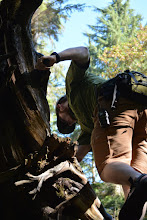Zoom Lenses
This is in response to thots about stuff's comment on another post. It seemed like it might be useful information, so I thought I'd put it up as a post.
"Zoom", when talking about lenses, refers to the ability to change focal length. Large (long) focal lengths bring things closer to you, and small (short) focal lengths provide a wider field of view.
The 18-55mm lens that comes with entry-level SLRs is an example of a zoom lens. There are wide-angle zoom lenses (Ex: Nikon's 12-24mm), normal zoom lenses (Canon's 28-80), and there are telephoto zoom lenses, which is anything longer than about 100mm* (Nikon's 600mm).
The opposite of zoom lenses is a prime lenses (Ex: Sigma's 30mm f/1.4) which are always stuck at one focal length. In other words, if you're using a prime lens, you have to move the camera to zoom in and out. They are generally cheaper than a zoom lens that includes the same focal length, in addition to being much smaller and lighter. From what I know, you can't buy a zoom lens that will go to f/1.4, but there are prime lenses that actually have f/1.0, which means that they have the same focal length as they do aperture, and will have a very small depth of field when at maximum aperture. Keep in mind that smaller aperture numbers indicate larger aperture sizes, which means more light hitting your film, sensor, AF, or eyes.
*This is not strictly true. Telephoto lenses have special optical properties, but I suspect that most photographers don't know or care about this.
"Zoom", when talking about lenses, refers to the ability to change focal length. Large (long) focal lengths bring things closer to you, and small (short) focal lengths provide a wider field of view.
The 18-55mm lens that comes with entry-level SLRs is an example of a zoom lens. There are wide-angle zoom lenses (Ex: Nikon's 12-24mm), normal zoom lenses (Canon's 28-80), and there are telephoto zoom lenses, which is anything longer than about 100mm* (Nikon's 600mm).
The opposite of zoom lenses is a prime lenses (Ex: Sigma's 30mm f/1.4) which are always stuck at one focal length. In other words, if you're using a prime lens, you have to move the camera to zoom in and out. They are generally cheaper than a zoom lens that includes the same focal length, in addition to being much smaller and lighter. From what I know, you can't buy a zoom lens that will go to f/1.4, but there are prime lenses that actually have f/1.0, which means that they have the same focal length as they do aperture, and will have a very small depth of field when at maximum aperture. Keep in mind that smaller aperture numbers indicate larger aperture sizes, which means more light hitting your film, sensor, AF, or eyes.
*This is not strictly true. Telephoto lenses have special optical properties, but I suspect that most photographers don't know or care about this.
Labels: lenses, photography tips


8 Comments:
:) Thank you :)
I did think it was telephoto lens that I was talking about, but I knew if I used that terminology I would probably be using it incorrectly, also. I appreciate your information -- thank you :)
I like your prime lens a lot, also. I think you use that one a lot, yes? In spite of the fact that I'm looking for "zoom" I might also like to get one of those first since they are more affordable, have good uses also, and I would get in the practice of thinking more in the idea of which lens to use for a certain situation and figure out which ones I really do want in the long run.
Thanks again for your good information!
I don't use my prime lens much here at all. Until the thing at Katsuragawa a few days ago, I had taken less than 20 pictures with it.
Out of about... cripes, I don't even know how many. A couple of thousand at least. I wouldn't consider a wise investment for someone about to come to Japan. Put it off at least until you get back to [wherever you're from].
Er, not that it's a bad lens. Japan is just too small to get much use out of a 50mm lens that has an effective 80mm due to crop factor. It's just nowhere near wide-angle enough. A 30mm would be an improvement, but would cost $400 at best.
I like to think of you being away at Hogwart's. So a telephoto lens actually moves the camera closer...magically. Well until you look up from the viewfinder. is this wrong?
I want to be able to take some of those pictures they take at Hogwart's...you know,the ones where the people are waving back...
What lens do I need for that? :)
One that's out of your budget range, and starting with the prefix "KH".
Yeah, that's not quite right. This page has a good demonstration if you scroll down a little bit.
Thank you! That page provides very good information in quite an understandable format, with good diagrams. Nice link! (of course) :)
Post a Comment
<< Home